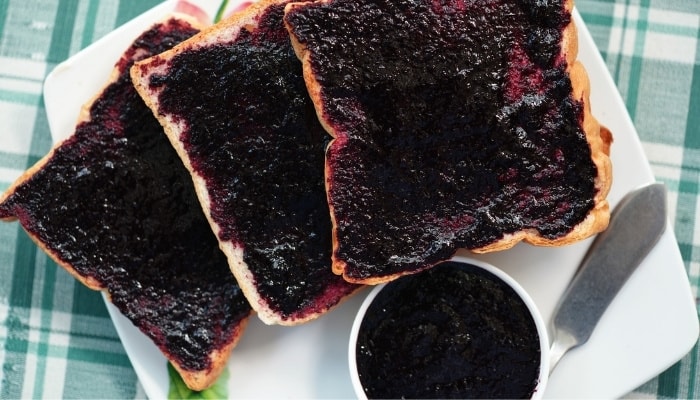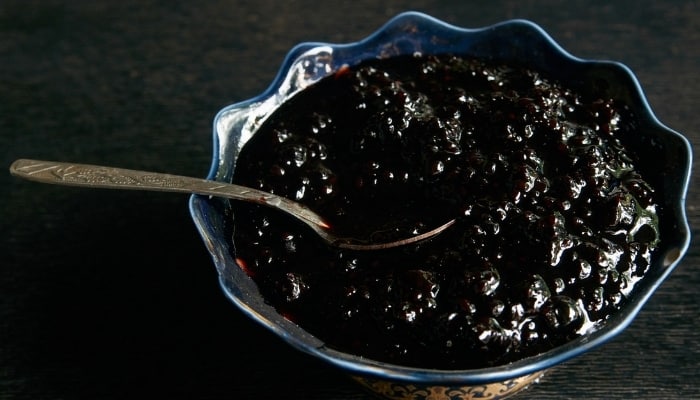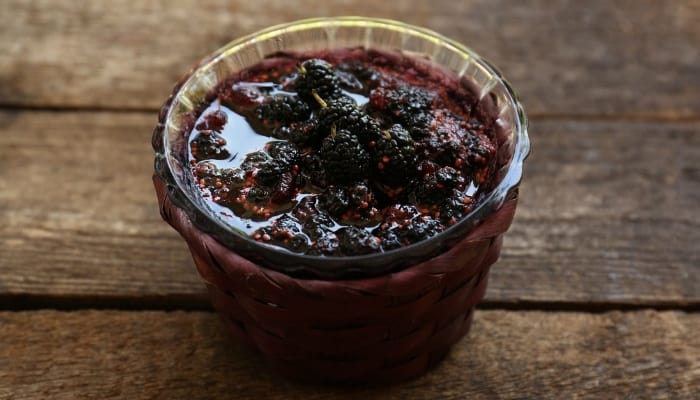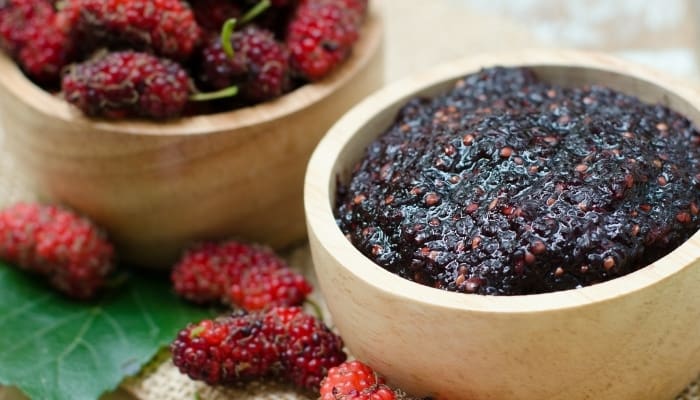The delicious mulberry fruit is often overlooked and underappreciated by many.
These deeply flavorsome, fruity, and sweet berries start to ripen at the height of summer, and we just can’t get enough of them.
The only drawback to these berries is their shelf life or lack thereof. When they’re ripe, they bruise easily and don’t transport well, so they need to be consumed quickly.
Fortunately, they can be utilized in many different ways from making your own dried fruit or tea infusions to even mulberry schnapps!
Below, we are going to be exploring three different methods to turn these summer beauties into good old-fashioned jam that can be enjoyed for up to two years if using sugar or pectin.
Recipe #1 – Mulberry Jam With Pectin

Making your own mulberry jam can be simple, fast, rewarding, and highly enjoyable.
Among the best ways for beginners to enter the world of sweet preserves is by using tried-and-tested methods. From there it’s totally up to you what ingredients you use — cooking should be an adventure!
Why use pectin in the first place? To put it simply, pectin is an acidic carbohydrate naturally found in certain foods like citrus peel, tart apples, and passionfruit.
Think of it as flour (another carbohydrate), and when using it as a thickening agent in soup or gravy, it’s the same basic principle.
Pectin also reduces the need for excess sugar, which is another ingredient used to thicken and preserve jellies and jams.
While this is a naturally occurring substance, the one drawback is that often it is a man-made chemical, developed from the real thing but can include any number of not-so-healthy ingredients.
Here we have a minimum-fuss recipe that tastes delicious and can be made in very little time.
Supplies & Ingredients Needed
- 19 oz. of mulberries (about 4 cups)
- 2 oz. of lemon juice (about ¼ cup)
- 6 oz. of raw cane sugar (about 1 cup)
- 2 teaspoons of pectin
- Large cooking pot
- Potato masher
- Wooden spoon
- Whisk
- Glass jars (old or new — both need sterilization) and canning lids
Instructions
- Sterilize jars and lids by washing them with warm soapy water, rinsing, and turning them upside down to dry (some people use a diluted sterilizing agent or heat sterilize in the oven — just make sure to cool jars before filling).
- In a small bowl, whisk together a few teaspoons of your sugar with the pectin powder (this reduces clumps formed by the pectin).
- Add mulberries to a large pot along with lemon juice, raw cane sugar, and the premixed sugar and pectin.
- Turn on low to medium heat, and simmer the mixture for around an hour. If you enjoy smooth jam, mash the simmering berries with a potato masher. For jam with texture, stir as little as possible while still making sure to gently check the bottom of the pot for sticking and potential burning.
- After about an hour, run a wooden spoon over the bottom of the pot. If it leaves a clear trail and gently runs back, it’s ready to place into jars. If it immediately covers the bottom again, it has not thickened enough and needs to simmer longer.
- Once ready, spoon or gently pour jam into jars, leaving about a quarter-inch space from the top. Then seal jars and water bath can them.
As the warm mixture cools, it will create a vacuum inside the jar, pulling down the lid and effectively sealing it. You should notice a dipped lid and a satisfying *pop* upon opening jars, just like a jar from the supermarket.
This jam can last for around two years in storage or 2-4 weeks in the fridge after opening (but it will probably be eaten before this time!).
Recipe #2 – Mulberry Jam Without Pectin

Creating homemade jam without pectin is still possible. In fact, this method is much older than using pectin. The only difference is that you add a little more sugar to act as a thickening agent.
This recipe is great for anyone who is prone to allergies from artificial ingredients or simply wants to use minimally processed ingredients in their home cooking.
Supplies & Ingredients Needed
- 19 oz. of mulberries (about 4 cups)
- 2 oz. of lemon juice (about ¼ cup)
- 8 oz. of raw cane sugar (about 1 ¼ cup)
- Large cooking pot
- Potato masher
- Wooden spoon
- Glass jars (old or new — both need sterilization) and canning lids
Instructions
- Sterilize jars and lids by washing them with warm soapy water, rinsing, and turning them upside down to dry.
- Add mulberries to a large pot along with lemon juice and raw cane sugar. (This recipe uses slightly more sugar as this helps with creating a desirable, thick consistency without pectin).
- Turn on low to medium heat, bring the mixture to a simmer, and let it cook for around an hour. If you enjoy smooth jam, mash the simmering berries with a potato masher. For jam with lots of texture, stir as little as possible, but make sure to gently check the bottom of the pot for sticking and potential burning.
- The mixture should be ready in around an hour or so. Because there is no added pectin, the old spoon test might not work for you, but the consistency should still be quite thick.
- Once you are happy with the jam, spoon or gently pour into sterilized jars, leaving about a quarter-inch space from the top. Then seal jars and process in a water bath according to safety guidelines.
As the warm mixture cools, it will create a vacuum inside the jar, pulling down the lid and effectively sealing it. You should notice a dipped lid, and a satisfying *pop* upon opening if it is sealed properly
This jelly should last for around a year in storage or 2-4 weeks in the fridge after opening.
Recipe #3 – Mulberry Jam Without Sugar

The healthiest way to make anything at home is to use the least amount of processed and artificial ingredients.
This recipe ticks the most boxes when it comes to health and nutrition — but don’t be fooled; fruit still contains a lot of natural sugar, which concentrates when making jelly or jam.
Keep in mind that what you gain from making a healthier alternative, you lose in the consistency of the end product.
Using pectin or sugar will firm the jam and create that traditional, deliciously gelatinous texture. Sugar is also a great preservative and will add lots of shelf life to your preserves.
Without the use of pectin or sugar, you will end up with a product that is more of a compote, but it still has its place in any pantry — this mulberry compote is fantastic poured over yogurt or ice cream, and, of course, you can still spread it on bread!
Supplies & Ingredients Needed
- 19 oz. of mulberries (about 4 cups)
- 2 oz. of lemon juice (about ¼ cup)
- Honey to taste (optional)
- Large cooking pot
- Potato masher
- Wooden spoon
- Glass jars (old or new — both need sterilization) and canning lids
Instructions
- Sterilize jars and lids by washing them with warm soapy water, rinsing, and turning them upside down to dry.
- Add mulberries to a large pot along with lemon juice.
- Turn on low to medium heat, and bring the mixture to a simmer. (Compote is best enjoyed with whole, intact berries, so it’s best to leave them intact through minimal stirring.) Cooking should be done in around 20 minutes.
- Compote can be used immediately or poured into sterilized jars and processed properly for later use.
Because this recipe lacks the vital preserving ingredient, sugar, it is best to make small batches, refrigerate, and consume within two weeks. However, some people report success at keeping it sealed and stored for months.
Also note that mulberries also naturally ripen in stages, and trees will bear ripe fruit for up to a month or more. So there’s no rush — you can make this quick recipe again and again with new harvests.
Conclusion
If you’re looking for an even more unusual jam to make, why not try using the sweeter white mulberry? These are harder to come by, but they are absolutely fabulous for their delicate, blossomy taste and high sugar content.
Why not try adding spice satchels in cheesecloth bags when cooking? Spices that go well with or complement mulberries are cinnamon, vanilla, cardamon, cloves, and star anise.
Half the fun of doing your own cooking projects at home is making creations that you can’t find anywhere else — these also make wonderful gifts that your friends, family, and neighbors will love.

